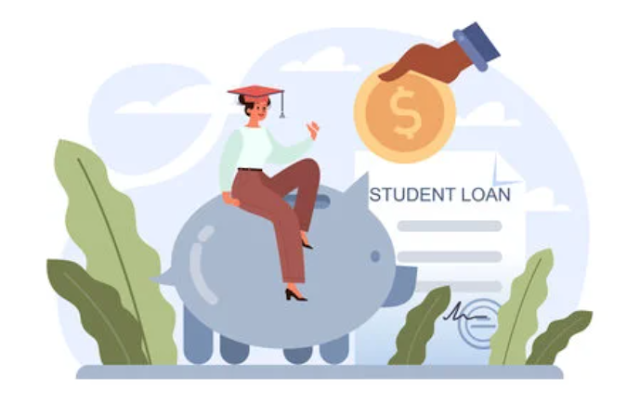A Complete Guide to Student Loans and Repayment Options
Pursuing
higher education is a rewarding investment in one's future, but it often comes
with a significant financial burden. Many students rely on student loans to
finance their education, and understanding the various types of student loans
and repayment options is crucial for managing debt responsibly. This complete
guide provides an in-depth overview of student loans, the different types available,
and the various repayment options to help students make informed financial
decisions.
1. Types of Student Loans:
a.
Federal Student Loans:
Federal student loans are funded and regulated by the U.S. Department of
Education. They offer several advantages, including fixed interest rates,
flexible repayment plans, and potential forgiveness programs. Federal loans are
typically more accessible to borrowers with no credit history or limited
income.
b.
Private Student Loans:
Private student loans are provided by private lenders, such as banks or credit
unions. They come with varying interest rates and terms, often based on the
borrower's creditworthiness. Private loans may be necessary for covering
educational expenses not met by federal loans, but they usually lack some of
the borrower protections offered by federal loans.
2. Subsidized vs. Unsubsidized Federal Loans:
a.
Subsidized Loans:
Subsidized federal loans are based on financial need. The government pays the
interest on these loans while the student is in school, during the grace
period, and during deferment periods. This feature helps keep the loan balance
from growing during these periods.
b.
Unsubsidized Loans:
Unsubsidized federal loans are available to both undergraduate and graduate
students regardless of financial need. Interest accrues on these loans from the
time they are disbursed, and borrowers are responsible for paying the interest
throughout the loan term.
3. Parent PLUS Loans:
Parent
PLUS loans are federal loans available to parents of dependent undergraduate
students. The loan amount is determined by the cost of attendance minus any
other financial aid received. Parents are responsible for repaying the loan,
and the interest rate is fixed.
4. Repayment Plans:
a.
Standard Repayment Plan:
The standard repayment plan is the default plan for federal student loans. It
involves fixed monthly payments over ten years. This plan results in higher
monthly payments but saves money on interest in the long run.
b. Income-Driven
Repayment Plans (IDR):
IDR plans set monthly payments based on the borrower's income and family size.
Examples of IDR plans include Income-Based Repayment (IBR), Pay As You Earn
(PAYE), Revised Pay As You Earn (REPAYE), and Income-Contingent Repayment
(ICR). These plans provide more affordable payments for borrowers facing
financial challenges, but they may extend the repayment term, resulting in
higher total interest paid.
c.
Graduated Repayment Plan:
The graduated repayment plan starts with lower monthly payments that gradually
increase over time. This plan is beneficial for borrowers expecting their
income to grow significantly in the future.
5. Loan Forgiveness and Discharge Programs:
a. Public
Service Loan Forgiveness (PSLF):
PSLF is available to borrowers who work for qualifying public service
organizations while making 120 qualifying payments under an IDR plan. After ten
years of eligible service and payments, the remaining loan balance may be
forgiven tax-free.
b.
Teacher Loan Forgiveness:
Teachers who work in low-income schools for five consecutive years may qualify
for up to $17,500 in loan forgiveness on select federal loans.
c. Closed
School Discharge: If
a school closes while a student is enrolled or shortly after, the student may
be eligible for a discharge of their federal student loans.
d. Total
and Permanent Disability Discharge:
Borrowers with permanent disabilities may qualify for a discharge of their
federal student loans.
6. Loan
Consolidation: Loan
consolidation allows borrowers to combine multiple federal student loans into
one loan with a single monthly payment. While it simplifies repayment, it may
result in a longer repayment term and potentially higher overall interest
costs.
7. Grace Period and Deferment Options:
a. Grace
Period: Federal
student loans typically offer a grace period after graduation, during which
borrowers do not have to make loan payments. The grace period is usually six
months but may vary depending on the loan type.
b.
Deferment: Deferment
allows borrowers to temporarily postpone loan payments for specific reasons,
such as returning to school, economic hardship, or military service. During
deferment, interest may continue to accrue on unsubsidized loans.
8.
Avoiding Default:
Defaulting on student loans can have severe consequences, including damage to
credit scores, wage garnishment, and loss of eligibility for future financial
aid. If borrowers face financial challenges, they should explore alternative
repayment plans or deferment options rather than defaulting.
Conclusion:
Student loans are a valuable tool that can make higher education accessible to many. Understanding the types of student loans available, their repayment options, and potential forgiveness programs is essential for making informed financial decisions. Before borrowing, students should carefully assess their needs, explore federal loan options, and consider the impact of repayment terms on their post-graduation budget. By proactively managing their student loans, borrowers can build a solid foundation for financial success after graduation while minimizing the burden of educational debt. Additionally, staying informed about various loan forgiveness and discharge programs can help borrowers plan for their financial future and utilize available resources effectively.










